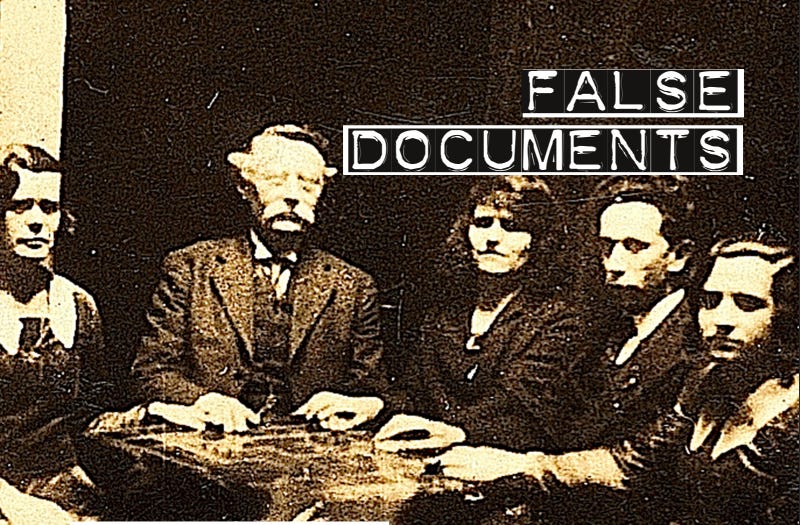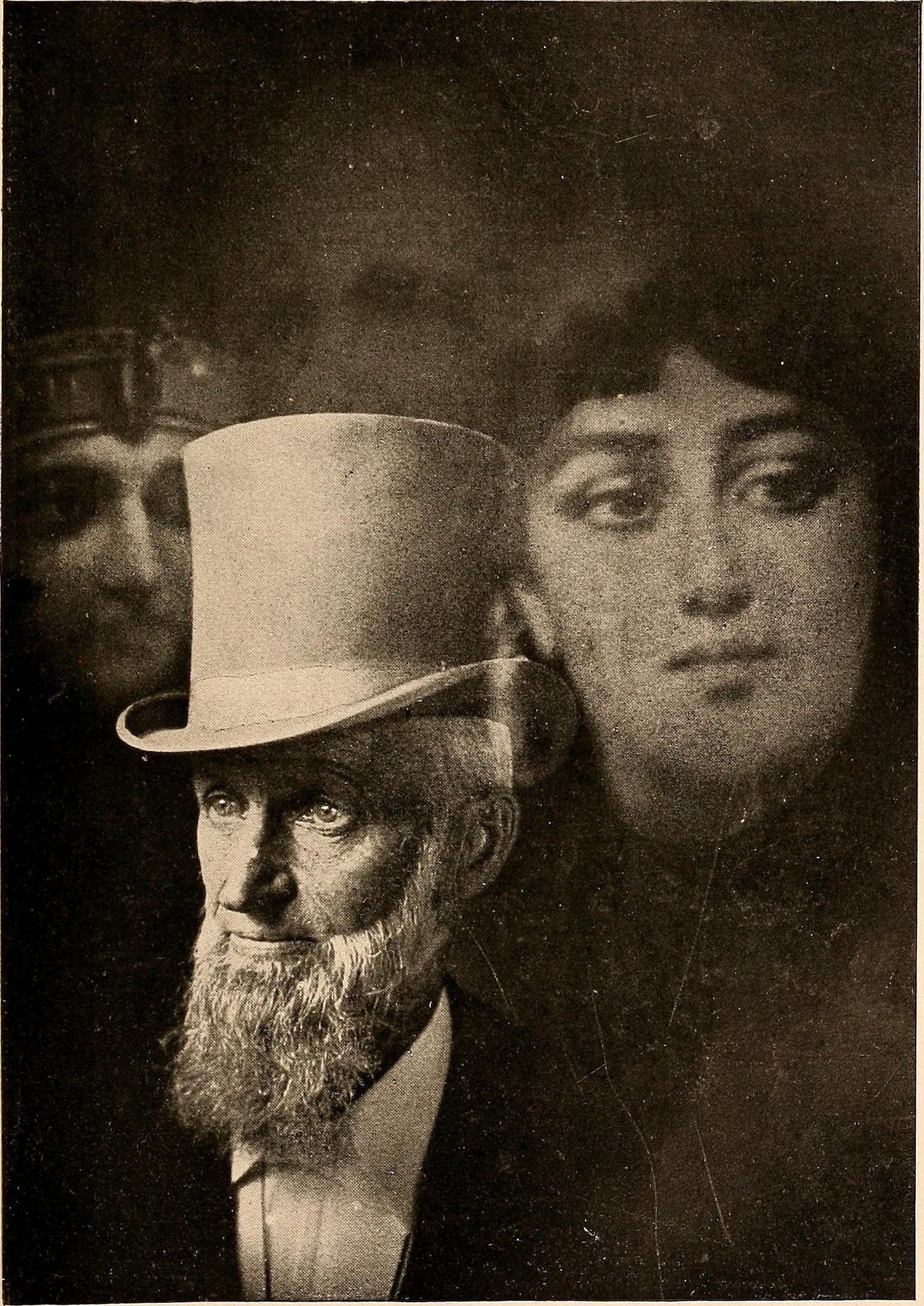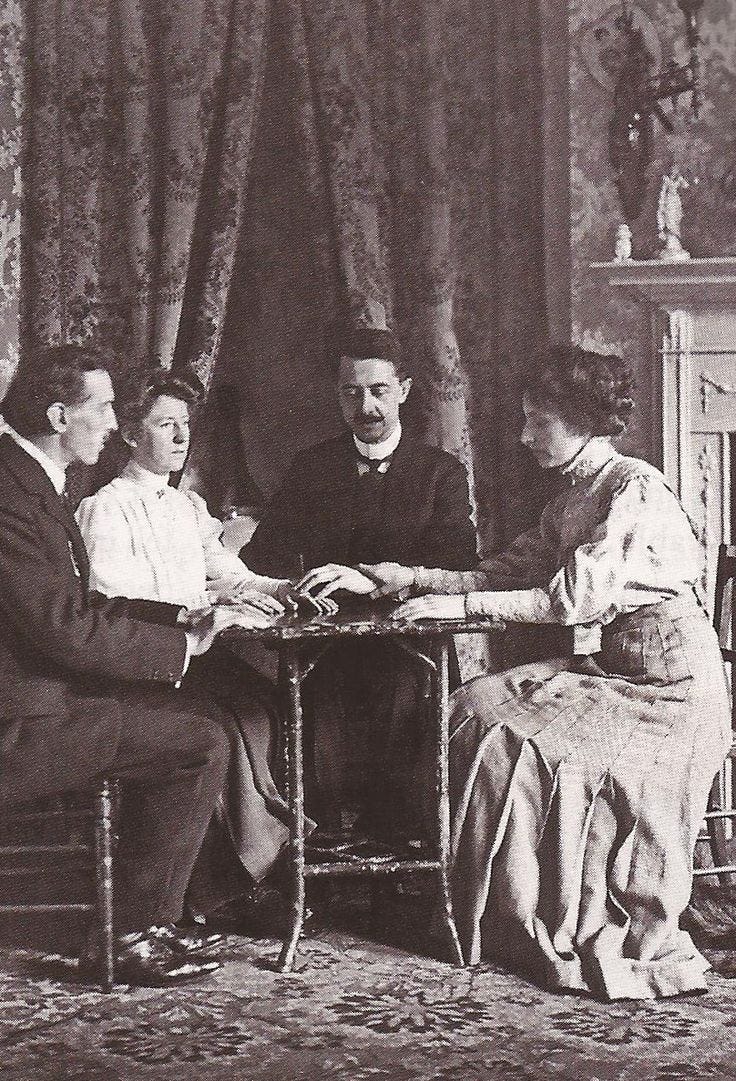False Documents: The Transcripts of the Medium Bayrolles
Tabletop RPG adventure seeds from the weird fiction of Ambrose Bierce, Robert W. Chambers, et. al.
A false document is a literary technique of inserting reference to a fictitious work within a larger work of fiction, with the goal of building mystery or lending depth and verisimilitude to a setting. Fictitious books like Tolkien’s Red Book of Westmarch or Lovecraft’s Necronomicon are known by almost everyone, but there are countless other examples that offer equally tantalizing possibilities for use in tabletop RPGs. False Documents will explore a different example in each installment, describe what it is and where it comes from, flesh it out, and offer ruleset agnostic suggestions on how you might use it in your own games.
(Other False Documents: The Joyce-Armstrong Fragment, the Deep School Manual, The Bruce-Partington Plans)
IV. Transcripts of the Medium Bayrolles
"O God! what a thing it is to be a ghost, cowering and shivering in an altered world, a prey to apprehension and despair!"
Sources
“An Inhabitant of Carcosa,” Ambrose Bierce (1886)
“Haita the Shepherd,” Ambrose Bierce (1891)
“The King in Yellow,” Robert W. Chambers (1895)
“The Moonlit Road,” Ambrose Bierce (1907)
Other names and locations from the writings of Manly Wade Wellman, H.P. Lovecraft, and David MacLean Parry
Canon
The enigmatic Bayrolles was a spiritualist and psychic medium who flourished in the second half of the 19th century. Bierce does not identify the medium’s full name, sex, or nationality, perhaps indicating rank among the household names of the era. Bayrolles channeled spirits both ancient, as in “An Inhabitant of Carcosa” and the more recently departed, as in “The Moonlit Road.”
Apocrypha
Horatio DuBois (1851-1904?), better known by the alias Bayrolles, was an American prominent in the Spiritualist movements of the 19th century and perhaps the most famous medium, or spirit channeler, in the United States prior to the Martian Invasion. He was steeped in the spirit world from an early age, first experiencing what his elder sister called “ecstatic fits and visions” in his youth. His psychic talents evidently ran in the family; his mother Anna was a ‘table-knocker’, and there has long been speculation that she was the same ‘Anna’ who was the subject of Baron Karl von Reichenbach’s famous study on ectoplasm and telekinesis. In any event, Horatio first publicly revealed his mediumistic talent in the aftermath of the Owl Creek Bridge train disaster of 1869, hoping to assuage the grieving families of the deceased. This made him a worldwide sensation and earned him many wealthy patrons, enabling him to become a professional spiritualist for the rest of his life. He assumed the alias ‘Bayrolles’ in 1872, allegedly to avoid violent religious persecution, though some have said his real purpose was an attempt at hiding his True Name from malicious astral entities.
Bayrolles was incredibly prolific as a medium, but he was perhaps most noteworthy for the close records he began keeping of each session. Starting in about 1870, his sessions were always accompanied by a stenographer, and by the 1890s, he began making phonographic recordings as well. Many of these survive today, filling eight large volumes, published by various spiritualist and parapsychological societies as The Transcripts of the Medium Bayrolles.
Most of the transcripts are of little interest to modern readers, filled with trivialities and personal communications that must hold little meaning to anyone without intimate acquaintance of the spirit. The chief interest in these recordings today comes from the rare incidents where he spontaneously channeled unlooked for spirits from unknown civilizations, and his harrowing descriptions of the bleak environs in which some of the dead found themselves.
Lost Civilizations of North America
The same psychic openness that allows a medium to become the spiritual vessel of a human shade also opens them up to the threat of possession and physical harm from malicious spirits. Consequently, most will avoid opening themselves up for spontaneous ‘walk-ins’. Such was Bayrolles’ self mastery, however, that he frequently “threw wide the gates” to unlooked-for spirits. It was in this way that he made contact with the ghosts of the truly ancient dead, members of civilizations and pre-human races that once ruled North America in prehistoric times.
The most famous and frequent of these was Hoseib Alar Robardin, a pre-Indian inhabitant of the Americas who had once lived in a great city called Carcosa. Robardin told of his descent from a race of trans-oceanic conquerors he called the Carq, but that the Theosophistis identified with mythical Atlantis. Robardin lived during the decline of his civilization, but he recounted the legends of his people: their shining cities upon the seas, their far-flung Scarlet Empire, and their conquest of a continent thick with inhuman monsters.
From details gleaned over his 38 recorded sessions with Robardin, Bayrolles calculated the last days of Carcosa and the Carq’s Scarlet Empire to 12,000 BC. The great medium became obsessed with fleshing out this past history, and sought out even more ancient spirits to fill in the gaps in his knowledge. Bayrolles eventually identified no less than six civilizations that ruled parts of the Americas in darkest prehistory, dating back (as he claimed) 250,000 years. Besides Robardin’s Carq, or as they were earlier known, the Arqi, there was grim, subterranean K’n-Yan; the gigantic hairy bell-makers of Yaktavia, the man-serpents of Yoth, the sorcerous Ashonikiwak or Shonokins, and barbaric, ice-bound Lomar. Some were human or nearly so, some masqueraded as men, and some were anything but.
It was these readings of precursor civilizations that drew the attention of the US government. Between 1887-1891, Bayrolles conducted a series of private readings for the US Secret Survey, an agency founded in the wake of the Lewis & Clark Expedition to catalog what they called “The American Peculiarities.” The USSS independently discovered evidence of some of these civilizations in their field operations, and feared that leftover artifacts or even hostile relict populations posed a threat to the country. Unlike Bayrolles’ other sessions, these were recorded only by the USSS and kept in their secret archives. How many of these recordings survived the Martian invasion, if any, is unknown.
The Nightlands
Bayrolles became accustomed to his ghostly communicants describing their bleak surroundings as a world of eternal night, lit only by the moon. Although disorienting and unfamiliar at first, the shades realized that this was the same world of the living, though altered by despair and an alien perception. In the words of the ghost of Julia Hetman:
“You think that we are of another world. No, we have knowledge of no world but yours, though for us it holds no sunlight, no warmth, no music, no laughter, no song of birds, nor any companionship… For, although the sun is lost to us forever, the moon, full-orbed or slender, remains to us. Sometimes it shines by night, sometimes by day, but always it rises and sets, as in that other life.”
Robardin described it thus:
“An owl on the branch of a decayed tree hooted dismally and was answered by another in the distance. Looking upward, I saw through a sudden rift in the clouds Aldebaran and the Hyades! In all this there was a hint of night—the lynx, the man with the torch, the owl. Yet I saw—I saw even the stars in absence of the darkness. I saw, but was apparently not seen nor heard.”
In Bayrolles meditations, he always referred to this grim and fearful landscape by one name: the Nightlands.
After years of mediumship, it became clear to Bayrolles that most of the shades that spoke through him perished violently, some by assassination, but most by wars of conquest. Hetman was the victim of murder; Robardin a warrior of his ancient race, and died during the sack of his city. Those who died otherwise eventually passed out of communication, and Bayrolles believed that he helped some of them escape the Nightlands to whatever reward awaited them. But those who died in long-ago wars or violent struggles seemed doomed to wander the Nightlands forever. Spanish conquistadors, Indian braves, French Voyageurs, battle-scarred English frontiersmen, Colonial American soldiers, Viking berserkers, Atlantean bravos, and a multitude of yet more ancient and alien fighting men, held in thrall to some mighty and nameless force.
The King in Yellow
In his waning years, Bayrolles focused his investigations on the religions of antediluvian North America and the Carq of Atlantis, for he believed that in these lay the secret of the Nightlands and the terrible force that held so many of the dead in bondage. He learned, via Robardin and others of his race, how the dark religion of the non-human inhabitants of North America was syncretized and brought back to the Carq colonies like Carcosa and metropolitan Atlantis itself just before its downfall. The alien faith soon eclipsed the Carq’s own ancient religion, corrupting once-benevolent deities like Hastur, the protector of shepherds, into colossal gods of shame and despair. Its exotic rites became more decadent and disquieting as the great conquering civilization declined.
Perhaps it was a matter of coincidence (then again, perhaps not…) that, at the same time Bayrolles was making his discoveries, the scandalous play The King in Yellow was first published (and quickly suppressed) in France. Bayrolles recognized a connection between it and the dark religion of the past. Its baroque excesses, the symbolic importance of the color yellow, and the way it spread contagious lunacy among the artistic set were all paralleled in the decline of the Carq. Fearful of exposing himself to the malicious effects of the play, he delayed reading it for several years. When he finally did, the great medium was greatly disturbed to find that it described events in the fall of Carcosa itself, some of which he had been told, but had never published.
Bayrolles lobbied strenuously for the suppression of artistic and occult movements that sprung up around the play and invested a considerable portion of his wealth into buying and destroying copies of the play. His efforts were futile, but thankfully, the seemingly irresistible influence of the King in Yellow was checked by the Martian invasion in the summer of 1898, one of the rare silver linings in the dark clouds that would cloak mankind for the next few decades.
Bayrolles’ End
Bayrolles’ death is mired in uncertainty. It is known that he survived much of the Martian War, and the Promethean recalled meeting him as late as 1904 in Pittsburgh. In the Promethean’s words:
“The great medium was a scarecrow of a man, bleak and ravaged by God only knows what horrors glimpsed by eyes both mundane and supernal. A grotesque tremor of the face afflicted him; this he judged the product of chronic insomnia. He never slept, he told me, but a few moments a night, for the voices of the War’s victims constantly assailed him. In this, he viewed his fame as curse, for it was his worldwide renown that caused the great multitude of the extinguished to seek him out personally, desirous of knowing the fate of loved ones, or sending some message to their heirs, or even to understand their incomprehensible death. Never have I given weight to the words of channelers, but it was impossible to doubt his haunted and pathetic condition, and a difficult thing to brush aside his testimony. I know not what became of the great Bayrolles, and I never saw him again.”
Here Bayrolles combines with local legend, for some say that the itinerant medium was making his way toward Pittsburgh’s Blight, that area of perpetually poisoned earth caused by baroque Martian weaponry. At the centre of the Blight, there is said to be a total psychic dead zone known as the Zone of Silence. Local superstition holds that the great medium went there, even knowing he would be killed by the life-destroying poisons in ground and water, so that he could at last perish in peace and quiet.
Gnosis
The published transcripts of Bayrolles’ sessions provide tantalizing hints about the secret, time-shrouded history of North America, the Nightlands, and the fate of the violently departed. However, great gaps and seeming inconsistencies remain in the transcripts, as indeed they did in Bayrolles’ own unsettled thoughts on these matters. Ultimately, they lay a solid groundwork for the aspiring fringe investigator, and a stepping stone into deeper esoteric research. The transcripts are relatively well known, and have exerted varying degrees of influence on modern studies of history, parapsychology, and occultism.
Plot Hooks
The Lost Readings
A volume of 24 readings, never before seen but reputedly signed by Bayrolles, is discovered by an antiquarian and offered at auction. In the lead up to a bidding war between wealthy occultists and crowdfunded fringe archaeologists, the PCs are hired to ascertain the volume’s authenticity. They’re forgeries, but it turns out they’re reproductions of a genuine volume, held by a shadowy third party. At some point, one or both are stolen and the PCs implicated in the crime. To make matters worse, a band of heavily armed Yellow Sign cultists is hunting the PCs, intent on retrieving the lost readings at any cost. The (true) documents may contain vital knowledge about contacting the dead, traveling to the Nightlands, or the location of treasure-filled ruins from the lost civilizations of North America.
The Voice of Robardin
A cult of violent revolutionaries influenced by the Yellow Sign called The Voice of Robardin has spread throughout the continent over the last two decades, growing rich on narco-trafficking, organ-legging, and the plundering of ancient cultural artifacts. Its membership runs the gamut from poor, illiterate farmers in the Yucatan to brainwashed old-money heiresses in New York and California. All of them are zealots and heavily armed. They claim to be led by the reincarnation of Hoseib Alar Robardin himself. But who is he really, and what is he after?
Raiders of Lost Lomar
Bayrolles’ readings for the US Secret Survey were thought lost in the Martian War, but what if they were really just misplaced by a lazy bureaucrat? They may be recovered along with related USSS studies, or even attack plans on targets like K’n-Yan or the Shonokins, plans that the PCs could adopt for their own relic-hunting expeditions. A historical campaign set in the late 19th century could feature PCs caught up in a USSS operation that’s sure to go badly.








